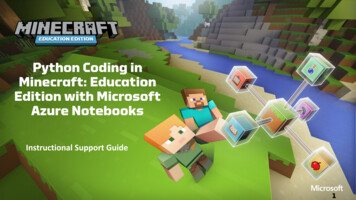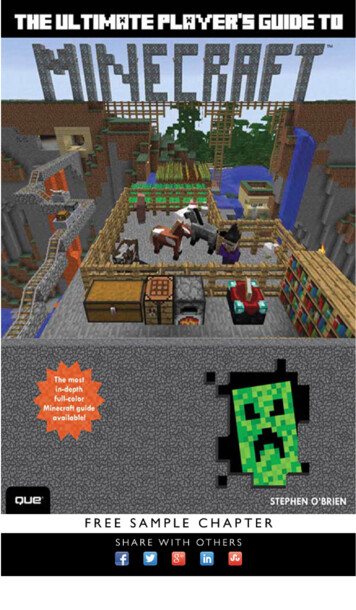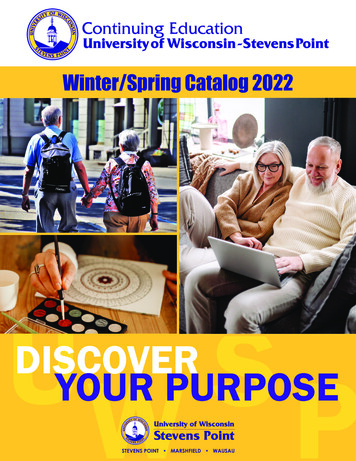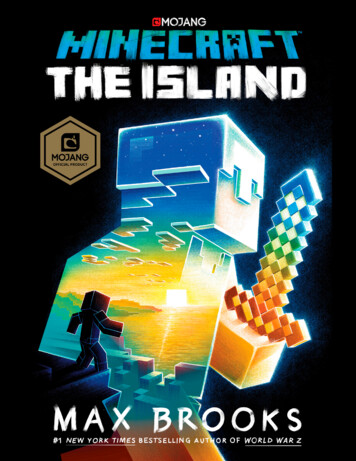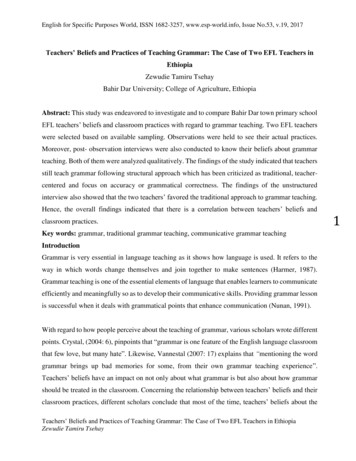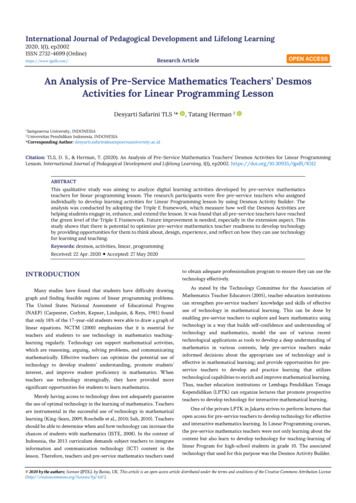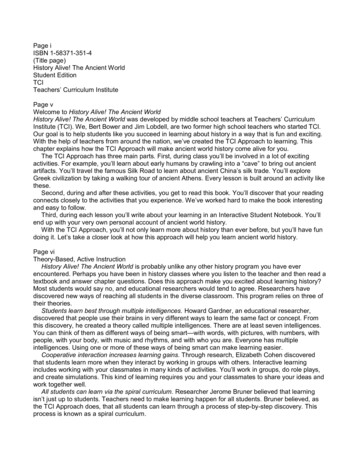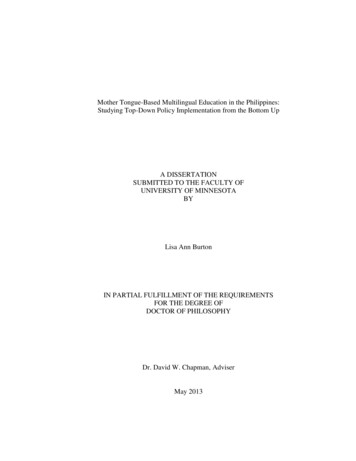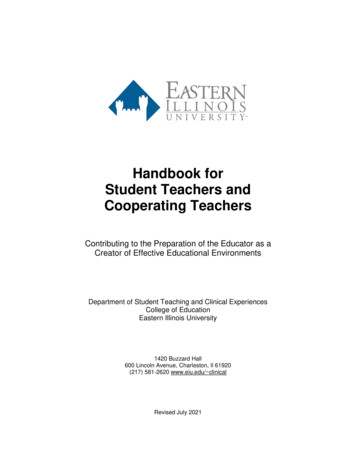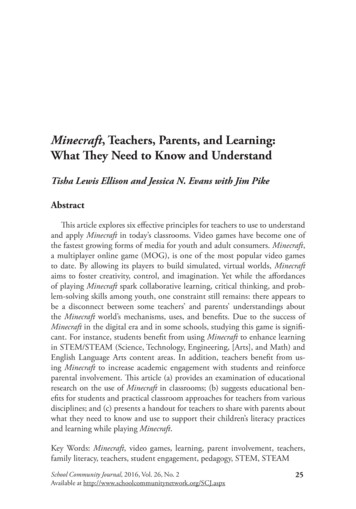
Transcription
Minecraft, Teachers, Parents, and Learning:What They Need to Know and UnderstandTisha Lewis Ellison and Jessica N. Evans with Jim PikeAbstractThis article explores six effective principles for teachers to use to understandand apply Minecraft in today’s classrooms. Video games have become one ofthe fastest growing forms of media for youth and adult consumers. Minecraft,a multiplayer online game (MOG), is one of the most popular video gamesto date. By allowing its players to build simulated, virtual worlds, Minecraftaims to foster creativity, control, and imagination. Yet while the affordancesof playing Minecraft spark collaborative learning, critical thinking, and problem-solving skills among youth, one constraint still remains: there appears tobe a disconnect between some teachers’ and parents’ understandings aboutthe Minecraft world’s mechanisms, uses, and benefits. Due to the success ofMinecraft in the digital era and in some schools, studying this game is significant. For instance, students benefit from using Minecraft to enhance learningin STEM/STEAM (Science, Technology, Engineering, [Arts], and Math) andEnglish Language Arts content areas. In addition, teachers benefit from using Minecraft to increase academic engagement with students and reinforceparental involvement. This article (a) provides an examination of educationalresearch on the use of Minecraft in classrooms; (b) suggests educational benefits for students and practical classroom approaches for teachers from variousdisciplines; and (c) presents a handout for teachers to share with parents aboutwhat they need to know and use to support their children’s literacy practicesand learning while playing Minecraft.Key Words: Minecraft, video games, learning, parent involvement, teachers,family literacy, teachers, student engagement, pedagogy, STEM, STEAMSchool Community Journal, 2016, Vol. 26, No. 2Available at http://www.schoolcommunitynetwork.org/SCJ.aspx25
SCHOOL COMMUNITY JOURNALIntroductionIn this article, we explore how teachers can utilize Minecraft in the classroomto promote creativity and learning in ways that would afford more educationalbenefits for students. Minecraft, a digital “sandbox” and pixilated video game,allows individuals to freely create and manipulate their own simulated worlds,which enables them to have full control to design these worlds in intentionalways. With over 100 million users registered (including 6 million Xbox gamers) in more than 66 countries, more than 1 billion hours played, and over 130million worlds created (Makuch, 2014), Minecraft is one of the most discussedvideo games for youth and adults (Junco, 2014) and adds to the high popularity of video gaming worldwide (Jenkins, 2006). We learned that Minecraft isnot simply a video game that allows youth to build and create virtual worlds;Minecraft has now become an educational tool used as a vehicle for teaching critical content. Youth who play this game have the ability to take controland be active learners, thus enhancing their motivation for learning (Junco,2014). It also acts as a supplement in today’s classrooms—a popular learningactivity in content areas such as science, math, history, engineering, architecture, and computer coding. Minecraft also helps students achieve the goals ofthe Common Core State Standards (Lorence, 2015; Magee, 2015). In fact,MinecraftEdu.com, a platform that is a replica of Minecraft, is made specifically for educational purposes.Figure 1. Screen Shot of Minecraft26
MINECRAFT AND LEARNINGFigure 2. Screen Shot of MinecraftEdu.comSituating and Positioning in MinecraftLewis Ellison, a former Title I reading/writing skills teacher and current researcher and teacher educator who has explored adolescents, adults, and families’digital literacy practices—particularly among African Americans (Lewis, 2011,2013, 2014; Lewis Ellison, 2014a, 2014b, 2016a; Lewis Ellison & Kirkland,2014)—and Evans, graduate student and former teacher with a backgroundin teaching adolescents how to create digital stories, collaborated with Pike,a fifth grade math teacher who created Mathcraft, a Minecraft curriculum, toshare their interests in gaming.We found that the more we talked openly aboutvideo games, played them, wrote about them, taught them, and shared themwith youth, their teachers, and parents, the more we noticed that Minecraft wasa popular game among both youth and adults. We have all felt the angst andconfusion of teachers and parents who are curious about Minecraft but do notknow the benefits of video games. The need for teachers and parents to understand students’ digital literacy practices and the extent to which youth live inthe virtual worlds of the 21st century is significant. Youth attend school all day,but text all the way home, then communicate on Facebook, send tweets to theirpeers, and play video games (Institute of Play, 2012). Today’s youth do notseparate their conversations between these worlds; rather, they extend them.However, some teachers do not yet understand students’ fascination with theMinecraft world because they do not know what Minecraft is, how students actually benefit from the game, or how to apply it to their curriculum.27
SCHOOL COMMUNITY JOURNALThere is an art to the design, manipulation, and overall practice of videogames like Minecraft that makes youth passionate about more than the devicethey hold in their hands. Hollett and Ehret (2014) describe how playing Minecraft reshapes the “social, relational space” in which adolescents use it and helpsthem understand this space of gameplay “as populated with agentive, affecting,and affected bodies—both human and nonhuman” (p. 2). That is, students areable to foster agency through this video game. Indeed, youth involvement withvideo games is often misunderstood by stakeholders (e.g., teachers, administrators, parents) as a practice that is irrelevant and time consuming. This dismissalmay stem from a lack of information on how, according to Renzhog, Anér,and Leijo (2013), video games are the “forefront of innovations and digital services, predicted to be one of the most growing forms of media and expected torise in sales to 82 billion in 2015” (p. 5). According to a 2008 Pew ResearchCenter report, 97% of adolescents play video games, and among 13–17 yearolds, 59% of girls and 84% of boys play video games either online or via theirphones (Lenhart, 2015; Lenhart et al., 2008). With this understanding, teachers can consider the educational benefits and possibilities of implementingvideo games like Minecraft to enhance students’ learning across content areas.As teachers come to understand the benefits of gaming for learning, they canalso share this information with parents, using it as an opportunity to increasecommunication and partnership between home and school. The affordances ofthis work lends itself to other ways that research can support parents in understanding the educational benefits of gaming, whether situated in pedagogicalpractices or social practices in the home (Di Salvo, Crowley, & Norwood,2008; Entertainment Software Association, 2014; Gee, 2003; Griffiths, 2002;Lewis Ellison, 2016b; Ulicsak & Wright, 2010; Wang Yu, 2009).Relevant Literature: Video Games, Learning, and MinecraftWhile some theorists claim that there is not enough scientific data to understand the relationship between video games and learning (Blunt, 2007),there is some evidence that recognizes the benefits to educational games andproblem-solving in K–12 schooling (Young et al., 2012). In addition, there liessubstantial research and practice from literacy researchers and theorists thatthere are concrete connections between video gaming and literacy learning(Conrad & Donaldson, 2004; Dezuanni, 2010; Gee, 2003, 2005; Griffiths,2002; Shaffer, Squire, Halverson, & Gee, 2005). In fact, Gee (2003) remindsus that when we learn to play video games, we are indeed learning a new literacyand that video games contribute to learning in principled ways. Additionally,as Norton-Meier (2005) states:28
MINECRAFT AND LEARNINGThe video game has the potential to push an individual to learn andthink cognitively, socially, and morally. Players actively create new virtual worlds; participate in complex decision making; and think reflectivelyabout choices that were made, including the design of the game. (p. 430)Video games like Minecraft provide vital benefits to youth, helping them toexpress and control their emotions, build strong social ties, and spark creativity, imagination, peer engagement, and teamwork (Alton, n.d.). These skills arebeneficial in the classroom, especially as education moves toward using cooperative and collaborative learning models which focus on knowledge as a socialconstruct (Pappas, 2014). Additionally, Gee (2003) states that to be an activelearner, one must experience the world in new ways, create affinity groups withlike-minded people, and use these elements to prepare for future learning. Gee(2000) describes affinity groups as having an “allegiance to, access to, and participation in specific practices” (p. 105); in this way, individuals in this spacecan “challenge players’ taken-for-granted perspectives on the world” (p. 140).While the digital divide has further separated those who have access to technology from those who do not, Gee (2003) also identifies an “acceleration divide”that extends beyond access to identify the gap between adults’ ideas about howyouth should use “technology, texts, and games in integrated ways” (p. 23) andthe ways in which youth actually use them.Video games like Minecraft are only one of many sources that support learning and literacy, but we must also point out that such sources generally help to“situate meaning in worlds of experience that is ultimately shared, collaborative, social, and cultural” (Gee, 2010, p. 189). Today’s students are no longerobservers in video games but are placed in positions where they can be creativeand make decisions that actually affect and change the gaming world (Barabet al., 2010).Processing Minecraft Multimodally and PedagogicallyMinecraft is particularly significant to learning because youth learn to process information in different ways. For instance, Minecraft offers multimodal(multiple modes of meaning) texts that allow youth to read images that carrymeaning beyond the words in a text to the realms of embodied movementand interaction (Dourish, 2001; Streeck, Goodwin, & LeBaron, 2011), as wellas visual images, sounds, and music (Kress & van Leeuwen, 1996, 2001). InMinecraft, there is limited use of written language, but the game offers multimodal modes including graphics, images, symbols, and “visuospatial reasoningskills” (Junco, 2014) that help learners create and manipulate objects in a virtual world. In enhancing cognitive ability, this skill has significance similarto constructing three-dimensional models, building complex structures, anddrawing (Mervis, Robinson, & Pani, 1999).29
SCHOOL COMMUNITY JOURNALWhile researchers are beginning to collect data about Minecraft and its impact on students’ learning, pedagogical practices on gaming in the classroomare also slowly being better understood and used by teachers. Research hasdescribed how Minecraft is used in various content areas such as social studies, math, science, and English Language Arts (ELA) to stimulate the creativeminds of today’s youth (Kenkel, 2015; Risberg, 2015). For instance, Pike, aformer third-grade teacher and parent from the Western U.S., became curious about Minecraft after he watched the game for the first time, and hesubsequently started using it to teach Common Core math, science, computerscience, and ELA. Pike mapped out his lessons based on the benchmark assessments his students took three times a year. He ultimately created a curriculumcalled Mathcraft, which helped raise his third grade students’ scores from 18%to 84% in one academic school year. He taught students in multiple grades touse Minecraft’s game blocks as hands-on manipulatives to create and solve mathproblems (see Figure 3).Figure 3. Mathcraft Algebra ArchitectureSaez-Lopez, Miller, Vázquez-Cano, and Domínguez-Garrido (2015) testedthe educational effectiveness of MinecraftEdu.com (a “school-ready remix” ofMinecraft) among sixth- to eighth-graders in a unit of history and architecture.Study participants were school students from the United States and Spain.30
MINECRAFT AND LEARNINGThe authors sought to understand students’ outcome improvement with MinecraftEdu.com; analyze students’ motivational, learning, and engagement levelswhen playing Minecraft in a history classroom; and assess the attitudes fromthe respective school communities (students, teachers, and parents) regardingthe implementation of MinecraftEdu.com in history. While teachers’ attitudeswere moderate and parents thought game-based learning was negative and awaste of time in the classroom, some did conclude that the use of this tooloutside the classroom might be better. However, students appreciated the implementation of MinecraftEdu.com in their classes because it afforded themthe opportunity to be in control and be active participants, protagonists, andcreators in their virtual worlds. The researchers concluded that there was an increase in creativity and learning in teachers’ implementation of MinecraftEdu.com in their classes (Saez-Lopez et al., 2015).In addition, an eighth-grade social studies teacher from the Midwest usedMinecraft to prompt students to write a constitution for colonies to elicit governmental and economic policies for slaves and Native Americans. Studentsused Minecraft to create a two-dimensional map to “.build town halls, blacksmith shops, churches, and farm land and later connect roads” to other virtualcolonies (Colias, 2015). Furthermore, Short (2013) described how he usedthree-dimensional (3-D) images in Minecraft in college settings. Such practicesprovided pedagogical strategies for students to learn biology, ecology, physics,and chemistry to (a) create 3-D maps of the human body (biology); (b) formbiomes through a map generator to display temperatures, heights, and watercolor (ecology); (c) use Minecraft blocks to develop how the earth structuresare built using water, color systems, and gravity (physics); and (d) design a 3-Dperiodic table of elements to highlight 3-D images of mathematical functionsin the Minecraft world. Another way of processing and situating video gameslike Minecraft is by examining the potential video game learning has for students with special needs.Video Gaming, Learning, and Students With Special NeedsResearch indicates how play is a significant mediator for learning and socialization (Piaget, 1951) and how computer/video games promote engagedlearning and motivation for students (Habgood, Ainsworth, & Benford, 2005;Ke, 2008; Ke & Abras, 2013). In addition, techniques in video games suchas virtual simulation and problem solving are also key components for activelearning (Gee, 2003). While there is limited research on the effects of Minecraftand learning among students with special needs, research has acknowledgedthat web-based games provide significant results for motivation and comprehension for these children (Rezaiyan, Mohammadi, & Fallah, 2007). While31
SCHOOL COMMUNITY JOURNALmore research is needed on the role of computer video games for students withspecial needs and their learning, Ke and Abras’s (2013) study explored the design features of three prealgebra video games used to create engagement andlearning for students with special learning needs. They found that the designof the games Lure of the Labyrinth, Ker-Splash, and Lemonade Stand used vital components to promote engagement and learning for these students. Thefollowing principles describe six effective principles for teachers to use to understand and apply Minecraft in today’s classrooms for all students.PrinciplesWithin this vein, we frame this article as a guide for teachers to use in theirclassrooms as instructional models for STEM, STEAM, and ELA-related unitlessons. By providing answers to six key questions, we provide pedagogicalapproaches teachers can use to not only acknowledge today’s digitally savvystudents’ funds of knowledge (knowledge students acquire from their family’shistorical and cultural backgrounds; Moll, Amanti, Neff, & Gonzalez, 1992),but also to create possibilities and affordances for students to support theirknowledge and learning across and beyond school borders.1. What is Minecraft, and why is it so popular?According to Mojang, LLC, the creator of Minecraft, this video game isabout placing blocks and building structures simple or grand and workingtogether or alone to create wonderful, imaginative things (Mojang, n.d.).Minecraft has a “three-dimensional Lego-like environment in which the usercan build and interact with a virtual world” (Bos, Wilder, Cook, & O’Donnell,2014, p. 56). Minecraft allows players to use their creativity to build worlds using pixelated blocks without any limitations. It also allows players to developtheir own creative spaces, explore the creative spaces of others, and interactwith players on various multiplayer public servers that are specially designedfor Minecrafters with specific subinterests. These servers provide Minecraftersopportunities to engage and create with other Minecraft enthusiasts from allover the world.In Minecraft, there are two modes in which youth operate: creative and survival. While creative is more open-ended, survival involves surviving a zombieapocalypse by finding shelter and food, outmaneuvering monsters and spiders, and so forth. Additionally, there are other survival subgames created byplayers, which involve competitive and collaborate play. Overall, Minecraft hasno agenda or rules, as there are no instructions, no winners or losers, and nolevels to reach and surpass. Therefore, the main objective of the game is to32
MINECRAFT AND LEARNINGfreely create sustainable worlds according to players’ own standards and thendo whatever one desires.It is also important to acknowledge that teachers should be aware that Minecraft does allow for actions/building/tearing down that would defy the laws ofphysics present in the real world. It is recommended that if teachers noticestudents engaging in such practice, they can use the moment as a teachablemoment—possibly prompting the student or whole class to consider or actually try out how this practice might work (or fail to work) in the classroom.2. How can I apply Minecraft in my classroom while meeting the CommonCore State Standards?Certain school districts have found that Minecraft assists students in notonly consuming content but in creating content in alignment with the Common Core State Standards (CCSS; Magee, 2015). Both Minecraft and theCCSS are bourgeoning in schools and other academic sectors, like digitallygeared nonprofit organizations and webinar providers. Minecraft can be used inthe classroom to effectively teach information in content areas like mathematics. Bos et al. (2014) states that the creative mode of Minecraft can be used toteach mathematics, particularly, “to explore such concepts as algebraic patterns,measurement, perimeter, area, and volume” (p. 56).Some of those concepts are explicitly stated in the CCSS for mathematics (CCSS. Math. Content. 3. MD. D. 8; CCSS. Math. Content. 3. MD.A. 1; 2). The specific domains listed under Mathematics CCSS that overlapwith Minecraft concepts include geometry, measurement and data, algebraicthinking, expressions, and equations (CCSS. Math. Content. 4. MD. A. 1; 2;CCSS. Math. Content. 5. MD. A. 1). Thus, with effective planning and preparation, playing Minecraft “becomes an opportunity to explore mathematicalideas within an online community” (Bos et al., 2014, p. 57).3. How might I use Minecraft to teach STEM, STEAM, and ELA-related content areas?There are a vast amount of tangible school-related projects and practicesthat teachers can use to modify in their classrooms. Below are just a few practical approaches teachers can use to teach with Minecraft in the classroom.STEMIn an effort to teach students about the cell structure, teachers can createan animal cell in Minecraft and allow students to move through each livingorganism and describe the shape and structures of each cell part and its role.33
SCHOOL COMMUNITY JOURNAL(Note: a more in-depth explanation of this lesson is located in this link: tephen-elford-minecraftedufeatured-educator)Most school and public libraries are providing ways to foster an interest inSTEM-related subjects, both inside and outside of the classroom, some by offering STEM programs such as Minecraft Building Clubs to students. Studentscan participate in building competitions to learn how to survive the world ofMinecraft.STEAMBased on the virtual worlds students build in the Minecraft game, studentscan take those skills, creativity, and imagination to bring the virtual worldsto life using arts and crafts. A school in the United Kingdom orchestrated“STEAM Week” to allow students to recreate Minecraft into STEAM, callingit “Bridgecraft.” Teachers can utilize this practice for elementary to high schoolstudents to design and build big algebraic and geometric shapes to include in“their world.” Educators posted photos of the shapes with the student creatorson the school’s blog and showcased them as an exhibit throughout their school.(For more information on Bridgecraft in action, view this link: ool-turned-minecraft-into-steam/)The STEAM conference provides activities for teachers, researchers, parents,and middle and high school students to encourage learning through projectbased workshops at various college universities. Many of these workshops areled by students. Teachers can encourage the attendance of all stakeholders toexplore and learn from STEAM workshops in physics, music, Robotics, andmore (for more information, see http://www.steamconf.org).Teachers can also participate in an online arts integration and STEAMconference over the summer to learn how to implement STEAM-related curriculum with students. Information on this conference can be found here:http://artsintegrationconference.com/.ELAIn order to enhance students’ reading comprehension and visualizationskills, students can use Minecraft to recreate different settings and scenes fromliterature they are currently reading and use the game to offer predictions onwhat might happen in the texts. This information can help students integrateinformation in multimedia formats and better understand various topics andissues (CCSS. ELA-Literacy. RI. 6.7).Teachers can log on to MinecraftEdu.com for helpful ways to use Minecraft in the ELA classroom to support learning through writing (journaling),34
MINECRAFT AND LEARNINGgraphic organizers (concept webs), diagrams (illustrations), and readers theaterworkshops (scriptwriting using Minecraft characters). More information to target ELA-themed subjects are found on this site: http://services.minecraftedu.com/wiki/Examples by Subject.4. How do I support students with special needs and their gaming practices?Choosing the right kinds of video games are fairly important for all students, especially students with special needs. Murray, Silver-Pacuilla, andHelsel (2007) recommend avoiding overly complex video game instructionsfor students with special needs. Teachers and families are encouraged to identify the kinds of skills the students need to improve for effective learning withvideo games to occur. Teachers can provide a mentor teacher and/or peers aswell as time accommodations for students to reinforce their learning, interactions, and engagement on the computer.5. What do I do if I have disengaged students who do not want to learn withMinecraft?Stephen Elford, an early adopter of MinecraftEdu.com and a math andscience teacher of 12- to 18-year-olds, taught an “Animal Cell 01” lesson (seehttps://www.youtube.com/watch?v kBUesxvMw74), during which he experienced difficulties with one female student who refused at first to engage inMinecraft to learn. In fact, the student preferred to learn via textbooks. Thestudent made comments such as “stupid,” “I hate games,” and “I don’t like it.I would just prefer to just do this stuff [referring to a textbook],” and initiallyrefused to engage in the lesson. The above cited video/audio demonstrates alive discussion between Elford and the student and his attempt to have thestudent work with the game and the textbook. For students who are moreskeptical or disengaged, it is important to state in the beginning of the lessonthat learning is not linear or static, but fluid and experiential and that by moving things around and throughout, as within Minecraft play, critical thinkingis developed.6. What kinds of resources are important to use Minecraft in classrooms?While there are many educational games that teachers may use in the classroom, very few have been highly popularized and satisfactorily educational forall students. However, Minecraft teaches students valuable skills that can beused across various content areas in the classroom. Due to the increased interest in Minecraft among school-aged students, teachers should know aboutresources that provide them with information on how to use various types oftechnology like Minecraft as educational tools.35
SCHOOL COMMUNITY JOURNALWebsites like MinecraftEdu.com not only provide educators with a versionof Minecraft specifically tailored to the field of education, but also provide lesson plans and information on how the game can be used to teach concepts invarious content areas. The site also includes forums for educators to communicate and prepare lesson plans. In addition, edWeb.net is a free professionalsocial network site for educators to share ideas, information, best practices, andtechnology support. EdWeb.net also provides a Web 2.0 platform, includingwikis, webinars, and blogs for collaboration and has offered many webinars ongame-based learning communities including Minecraft.If teachers want to extend learning across borders with their students andincorporate Minecraft into their school curricula, it is recommended that theyfirst play the game and learn its components. In this way, teachers can betterunderstand how digital technologies affect student achievement and promotesuccess in creative and innovative ways that are safe yet challenging for alllearners. Some action steps to consider to initiate further learning: 36Watch Jane McGonigal’s TED talk, “Gaming Can Make a Better World”to understand the benefits of playing online games: https://www.ted.com/talks/jane mcgonigal gaming can make a better world?language eWatch Stephen Foster’s TED talk, “Minecraft: Keep Calm and Code On”about Minecraft and coding and the advantages it has for our future:https://www.youtube.com/watch?v mn4RHIxriEYSubscribe to www.edWeb.net to participate in asynchronous and synchronous webinars about Minecraft and other video games, and sign up forthe Daily Digest to receive relevant posts about professional learning fromvarious edWeb learning communities.Share articles like this one and links to online sites such as https://education.minecraft.net/ and www.edutopia.org with other teachers and parents(see Appendix. Minecraft Cheat Sheet for Parents), then offer to host discussions (perhaps at Parent–Teacher Association/Organization meetings orfamily literacy night) on ways to make Minecraft more learner-friendly inthe classroom and at home.Skype/invite a teacher currently implementing Minecraft into the classroom (individually and/or collaboratively with students) to share relevantin-class approaches.Watch one of the classroom links from Table 1 using Minecraft as a practical tool with students and discuss with students ways in which their individualized learning can be enhanced.Consider starting a Minecraft group for teachers as part of a professionaldevelopment day.Investigate some of the other helpful resources included in Table 1.
MINECRAFT AND LEARNINGTable 1. Resources for Using Minecraft in the ClassroomWebinars h-common-core-math/ t-with-math-for-exponential-learning/ ites http://mathcraftplc.com/ m-andrew-miller http://www.minecrap.com/minecraft-sites/Video Lessons* https://www.youtube.com/watch?v 88Cg8sqalpM https://www.youtube.com/watch?v 4R8bPo9fxWU https://www.youtube.com/watch?v Q7XwEbo-Ni0BooksDikkers, S. (2015). Teachercraft: How teachers learn to use Minecraft in their classrooms. Pittsburgh, PA: ETC Press.Gallagher, C. (2014). An educator’s guide to using Minecraft in the classroom: Ideas,inspiration, and student projects for teachers. San Francisco, CA: Peachpit Press.Whale, D., & O’Hanlon, M. (2014). Adventures in Minecraft. London, UK: WileyPress.Student Work* https://www.youtube.com/watch?v Ea7RFPjC1sw https://www.youtube.com/watch?v WWs1JDQan3k https://www.youtube.com/watch?v BIfr2em9yR8* School-based information was provided by Pike.Conclusions and ImplicationsIn this article, we described six principles that teachers need to know andunderstand about Minecraft. While Minecraft is just one way to actively engage teachers with students’ in-school practices, this article demonstrates howMinecraft is relevant in and out of the classroom. By implementing Minecraft37
SCHOOL COMMUNITY JOURNALinto the classroom curriculum, it provides a space in which students can freelyplay and maneuver Minecraft and foster creativity, control, and imagination.While today’s youth will continue to reinvent themselves within video gameslike Minecraft in this ever-changing, increasingly digital societ
ture, and computer coding. Minecraft also helps students achieve the goals of the Common Core State Standards (Lorence, 2015; Magee, 2015). In fact, MinecraftEdu.com, a platform that is a replica of Min
